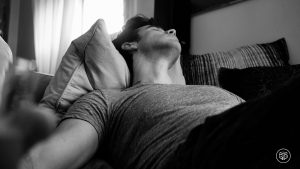Sleep is briefly defined as a particular loss of consciousness characterized by a variety of behavioural and neurophysiological effects.
It is worth mentioning that the best research on human sleep is carried out in a Sleep Laboratory which is usually located at a university or medical centre. A Sleep Laboratory comprises one or several small bedrooms adjacent to an Observation Room where the experimenter spends the night by preparing the sleeper for electrophysiological measurements which are conducted by attaching electrodes to the scalp so as to monitor the Electroencephalogram (EEG) as well as to the chin in order to monitor muscle activity that is recorded as Electromyogram (EMG). Furthermore, electrodes attached around the eyes monitor eye movements which are recorded as Electro-oculogram (EOG). Apart from the foresaid, other electrodes and devices may be used in order to observe and record autonomic activity such as heart rate, respiration and skin conductance.
Wakefulness
During wakefulness, the EEG of a normal person shows two basic patterns of activity called Alpha and Beta. The alpha activity consists of regular, medium-frequency waves of 8-12 Hz which is produced when a person is resting quietly. Although Alpha Waves sometimes occur when a person’s eyes are open, they are much more prevalent when the eyes are closed. The frequency of Beta activity ranges between 13-30 Hz and it is generally associated with a state of arousal. For example, Beta activity is recorded, when a person is alert and attentive to events in the environment or is thinking actively.
The importance of Alpha and Beta activity lies in the fact that the EEG is a recording of the summed postsynaptic activity of cerebral neurons – mostly neurons in the cerebral cortex. The cerebral cortex is the outermost layer of the grey matter of the two cerebral hemispheres which are portions of the forebrain. It is to be noted that the low-frequency, high voltage EEG of the Alpha Activity reflects neural synchrony as it is produced by a regular, synchronized pattern of activity in a large number of neurons. Oppositely, Beta Activity is referred to as desynchrony because it is produced by the alert, waking state of the brain where desynchronization occurs due to the volume of the information processing that takes place.
Sleep Cycle
Each sleep cycle is approximately 90 minutes long, containing a 20- to a 30-minute bout of Rapid Eye Movement (REM) sleep. Therefore, an 8-hour sleep will contain four or five periods of REM sleep. The fact that REM Sleep occurs at regular 90-minute intervals suggests that a brain mechanism alternately causes REM and Slow-Wave Sleep. Normally, a period of slow-wave sleep must precede REM sleep. In addition, there is a refractory period, after each occurrence of REM sleep, which prevents REM sleep to take place again during the foresaid period. The cyclical nature of REM sleep seems to be controlled by an “internal clock” which is believed to be located in the medulla which is the most caudal portion of the brain and it is located in the myelencephalon, immediately rostral to the spinal cord. The “ internal clock” causes regular changes in activity and alertness during the day while it controls periods of slow-wave and REM sleep at night.
The Sleep Cycle is typically divided into Rapid Eye Movement (REM ) Sleep and NREM (or non-REM) sleep. REM sleep is characterized by the rapid eye movements and several less detectible but important factors which include a lack of delta waves (slow, large amplitude brain waves), flaccid musculature, fluctuating heartbeat, erratic respiration, genital changes and, significantly, dreaming. On the other hand, NREM sleep is usually divided into four separate stages based on the proportion of Delta Waves observed.
STAGE-1
A person becomes drowsy and soon enters stage 1 Sleep, marked by the presence of some Theta Activity  (3.5-7.5 Hz). This stage is actually a transition between sleep and wakefulness. During this stage, the eyelids of the person open and close and the eyes roll upward and downward. After about 10 minutes the person enters Stage 2 Sleep.
(3.5-7.5 Hz). This stage is actually a transition between sleep and wakefulness. During this stage, the eyelids of the person open and close and the eyes roll upward and downward. After about 10 minutes the person enters Stage 2 Sleep.
STAGE-2
The EEG during this stage is generally irregular but contains periods of Theta Activity, Sleep Spindles  and K complexes. Sleep spindles are short bursts of waves of 12-14 Hz that occur between two and five times a minute during stages 1-4 of Sleep. Some research supports that Sleep Spindles represent the activity of a mechanism that decreases the brain’s sensitivity to sensory input. As the brain “disconnects” from the outside world, the person is allowed to enter deeper stages of sleep. It is worth mentioning that the sleep of older people contains fewer sleep spindles and it is, generally, accompanied by more awakenings during the night. K complexes are sudden, sharp waveforms which, unlike sleep spindles, are usually found only during Stage 2 sleep. They spontaneously occur at the rate of approximately one per minute. They can often be triggered by noises – especially, unexpected noises. Medical research supports that K complexes represent mechanisms involved in keeping a person asleep.
and K complexes. Sleep spindles are short bursts of waves of 12-14 Hz that occur between two and five times a minute during stages 1-4 of Sleep. Some research supports that Sleep Spindles represent the activity of a mechanism that decreases the brain’s sensitivity to sensory input. As the brain “disconnects” from the outside world, the person is allowed to enter deeper stages of sleep. It is worth mentioning that the sleep of older people contains fewer sleep spindles and it is, generally, accompanied by more awakenings during the night. K complexes are sudden, sharp waveforms which, unlike sleep spindles, are usually found only during Stage 2 sleep. They spontaneously occur at the rate of approximately one per minute. They can often be triggered by noises – especially, unexpected noises. Medical research supports that K complexes represent mechanisms involved in keeping a person asleep.
STAGES-3 and 4
 About 15 minutes later the person enters Stage 3 Sleep which is signalled by the occurrence of high-amplitude Delta Activity (less than 3.5 Hz). Delta Activity is a regular synchronous electrical activity which occurs during the deepest stages of Slow-Wave Sleep. The distinction between Stage 3 and Stage 4 is not clear-cut. Stage 3 contains 20-50 % Delta Activity and Stage 4 contains more than 50 per cent.
About 15 minutes later the person enters Stage 3 Sleep which is signalled by the occurrence of high-amplitude Delta Activity (less than 3.5 Hz). Delta Activity is a regular synchronous electrical activity which occurs during the deepest stages of Slow-Wave Sleep. The distinction between Stage 3 and Stage 4 is not clear-cut. Stage 3 contains 20-50 % Delta Activity and Stage 4 contains more than 50 per cent.
Not surprisingly, Stages 3 and 4 are often referred to collectively as Slow-Wave Sleep (SWS). It is worth mentioning that Theta Activity is the EEG activity of 5-8 Hz that occurs intermittently during the early stages of slow-wave sleep and REM Sleep. Furthermore, Stages 3 and 4 are characterized by a lack of REM, a regular heartbeat, rhythmic respiration, low levels of metabolic activity and moderate-to-high muscle tone.
REM Sleep
About 90 minutes after the beginning of sleep (and about 45 minutes after the onset of Stage 4 Sleep), an abrupt change in a number of physiological measures occurs. The EEG suddenly becomes mostly desynchronized with a sprinkling of Theta waves very similar to those recorded during Stage 1 Sleep. Furthermore, the eyes are rapidly darting back and forth beneath the closed eyelids. This activity is observed in the EOG which is recorded from electrodes attached to the skin around the eyes or the eye movements can be observed directly as the cornea produces a bulge in the closed eyelids that can be seen to move about. Additionally, the EMG becomes silent because there is a profound loss of muscle tonus. Physiological studies show that, aside from occasional twitching, a person actually becomes paralyzed during REM sleep. REM Sleep is also called Paradoxical Sleep, due to the presence of Beta Activity, that is usually noticed during wakefulness or Stage 1 Sleep.
It is believed that Stages 1 and 2 are less important than the others because when people are sleep deprived, they make up most of their slow-wave sleep and REM Sleep but not their Stage 1 and Stage 2 Sleep. By some criteria, Stage 4 is the deepest stage of sleep as only loud noises will cause a person to awaken and, when awakened, the person acts groggy and confused. During REM sleep a person may not react to noises but he or she is easily aroused by meaningful stimuli such as the sound of his or her name. Also, when awakened from REM sleep, a person appears alert and attentive.
Even though dreaming is strongly associated with REM sleep, there is roughly a 15% chance that dreams will be reported by persons woken from NREM sleep. However, these dreams lack the clear imagery, emotional tone and structure of REM sleep dreams. It is to be noted that a variety of atypical sleep phenomena such as Somnambulism(Sleep Walking) and Pavor Nocturnus (Night Terror) tend to occur during Stage 4 of Sleep.
Written by Gabriella Philippou, Psychotherapist-Counsellor, Focusing Experiential Therapist, Trainer, Coach




